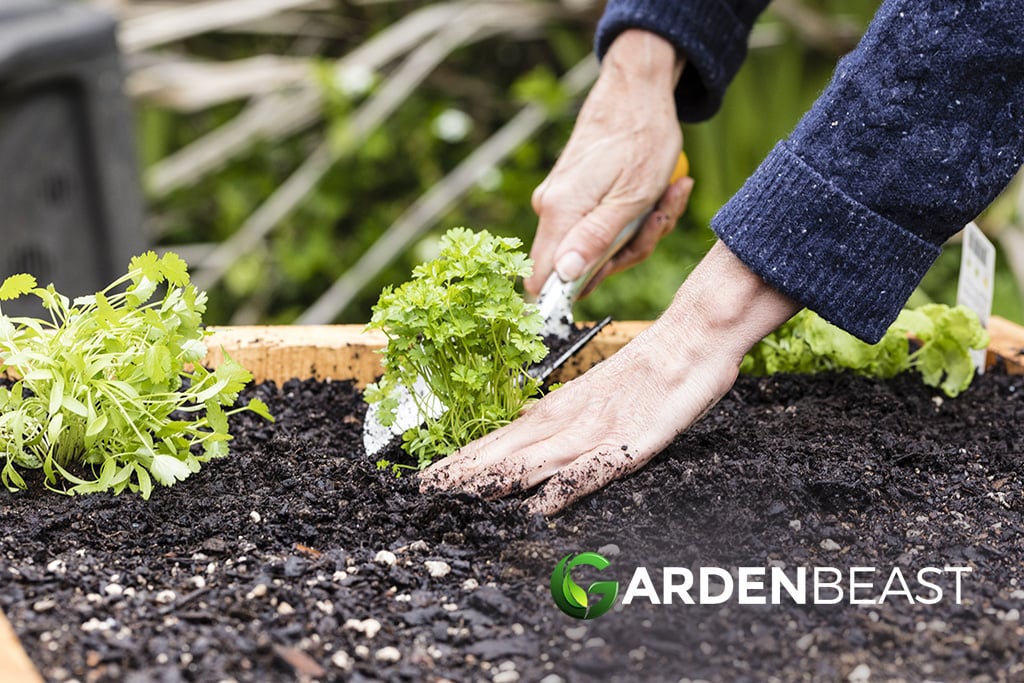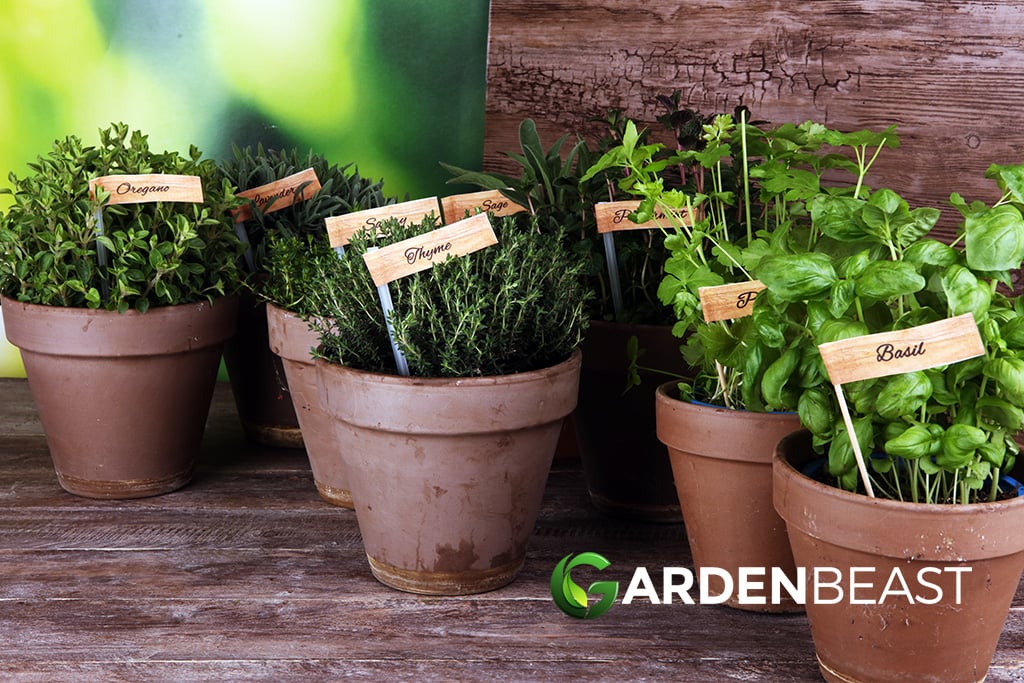Do you love using herbs in your cooking? Wouldn’t it be great to have fresh herbs available for your meals every day? You can make it a reality by starting a herb garden, it’s not as challenging as you think, and you can even create one on your kitchen windowsill!
Sprinkling herbs over your food enhances the meal’s flavor, and with a home herb garden, you have your choice of favorite herbs to grow. Growing an herb garden also enhances the aromatics around your veggie patch, and many of them offer protective benefits for your garden, steering pests and deer away from the rest of your crop.
Herbs have culinary and medical uses, and every home needs an herb garden to enhance the nutritional value of their meals. This post unpacks everything you need to know about growing an herb garden yourself.
We’ll look at different planting and growing methods, from starting an outdoor garden to growing on your kitchen shelf or a window box. You can create your garden with established seedlings or grow directly from seed; the choice is up to you.
There are dozens of herb varieties, and the biggest challenge you’ll face with starting your garden is deciding on your favorite options to plant. Let’s dive right into growing an herb garden at home.
What are the Optimal Growing Conditions for an Herb Garden?
Before you start choosing and planting herbs, you’ll need to find a suitable place for planting. Here are the growing conditions you need for the best results with your new project.
Sunlight
Most herb varieties need planting and growing in the full sun. They prefer the morning light, with shady conditions in the afternoon. We recommend planting in an area that gets you at least eight hours of sunlight each day.
It’s important to consider the changes in sunlight as the season progresses. If you’re planting your herbs in the garden, you’ll need to check that your planting spot doesn’t lose light as the growing season progresses.
It’s easy to misinterpret the sun’s movement, and you don’t want to plant in one spot that gets sunlight in the early part of the season, only to become shady in the later months. Keep that in mind when choosing your planting spot.
Afternoon shade is another essential requirement, as the plants need to recover from the strong sunlight during the morning and midday. Many herb varieties, such as lemon balm, bay laurel, parsley, and mint, enjoy the shade in the afternoon, and they also tolerate shadier growing conditions than many other herbs.
You’ll need to decide on the right herbs to match your culinary needs and your growing conditions.

The Soil
Plants need sun, air, water, and soil to thrive.
Herbs like nutrient-rich soil offering excellent drainage for the roots. Make sure the soil drains well, or you’ll end up waterlogging the roots. Waterlogging of the earth eventually turns to root rot in your plants, ruining the harvest.
If your garden soil is clay-like or doesn’t offer good drainage, consider planting in a raised bed or container. To improve the drainage in these mediums, we recommend placing a layer of granite stones at the bottom of the raised bed or container to improve drainage.
Use light, loamy soil that allows for optimal airflow and drainage around the roots. Herbs prefer growing in soil conditions with a pH of between 6.0 to 7.0; the soil should have a slightly acidic base to it, but not overly acidic as it stunts growth and limits the harvest potential of your herb garden.
If you’re planting in containers, we recommend purchasing a high-quality potting mix from the nursery. These potting mixes come with sufficient nutrients to sustain the growth of your herb garden, without the need to add additional amendments and fertilizers to the soil during the growing season.
Watering Your Herb Garden
Some herbs require more water than others. Therefore, it’s a good idea to grow each herb variety in a separate container or patch of the veggie garden. For instance, basil is a heavy drinker, requiring more water than most other herb varieties.
If you’re planting in drier areas, consider varieties like sage with lower water requirements during the growing season. Sage is also a fantastic herb for use in xeriscaping projects.
Let the soil dry out slightly between watering sessions. To check if soil conditions are perfect, the top of the ground should be dry, but you should feel moist soil if you stick your finger about half an inch into the growing medium. Water as necessary, but remember not to overwater your herb garden.
Herb Gardening Methods
There are several ways to grow your herb garden, and this section covers all of them. Choose the method that matches your yard, climate, and growing conditions for the best results.
Landscape Planting
If you’re growing your herbs in a vegetable garden, you can use them as companion plants to the rest of your produce. Many herb varieties, such as rosemary, drive away pests from the rest of your plants. Planting in a veggie patch or dedicated outdoor space also allows for the biggest yields.
When planting, follow the guidelines for spacing your seedlings according to the specific herb variety. The herbs also function as foundational plantings, allowing you to plan your other fruits and vegetables around your herbs.
However, you’ll need to ensure that the ground has the right sunlight and soil conditions. If you plant in clay soils, it results in poor absorption of water, less airflow, and smaller herbs. Some varieties might not even establish themselves in the ground if it has a high clay concentration.
The Raised Bed
The raised bed is an excellent option for growing your herbs outdoors. You can choose any area of the yard with the right sunlight conditions and set up your herb garden.
The shape and size of raised beds vary, but they all serve the same purpose. The raised bed allows gardeners to create the herbs’ ideal soil and drainage conditions, allowing them to thrive. Raised beds also allow for better airflow around the roots of the herbs, improving growth rates and yields during the growing season.

Raised beds are easy to make and cost-effective. You can put a raised bed together using reclaimed wood from old pallets or other sources.
The highest cost with this gardening method is the soil. Suppose you’re planting a small bed; it’s somewhat financially viable. However, large beds requiring more soil may make the exercise uneconomical for some gardeners.
The Planter
Planters are a viable option for growing your herb garden. You have hundreds of options for premade planters, and they come in a range of designs, with colors and patterns to suit the décor around the exterior of your home or the garden.
Planters offer you easy installation anywhere in the yard, and you can move them around during the growing season to make the most of the sunlight hours in the day. You also have the option of bringing your planters indoors during the winter, allowing you to keep your herb garden growing under artificial lights indoors.
Window Boxes
The window box is another viable choice for your new herb garden, and it’s a great option for apartments and smaller homes without backyards. The window box sits or hands on your windowsill, offering you the same advantages as a planter.
Window boxes come in a variety of designs, colors, and styles, with plenty of options to suit the exterior décor of your home. However, they do dry out faster than planters, and you only have limited planting space for a few herb varieties.
Pots
Pots also offer you another option for a small herb garden. You can plant three or four pots with your favorite variety of herbs and leave them to grow at their leisure. Pots are also suitable for growing indoors, and you can leave them on a windowsill in the kitchen.
Growing in pots is a great option for apartments and other small living spaces where you don’t have access to a window box or patio for a planter. Terracotta pots are a great choice; they offer plenty of airflow to the roots and an attractive finish that looks great on the windowsill or out on the patio.

Should You Choose to Grow from Seeds or Seedlings?
It’s possible to start many different varieties of herbs from seeds without any hassle. You can start the seeds indoors and then move them outdoors once the plants establish.
Growing from seed is more cost-effective than purchasing seedlings. However, with seedlings, you get a faster start, and there’s less chance of your plants dying on you during the initial stages of growth.
Growing from seedlings is the better choice for the inexperienced gardener, as most issues with herbs occur in the seed to the seedling stage of growth. Once the plants establish, they offer much easier care.
Your local nursery should carry a huge selection of seedlings available for planting in the garden right away.

1 Comment
I think I need to get a pot of cilantro for indoors—I miss that freshness in the winter!